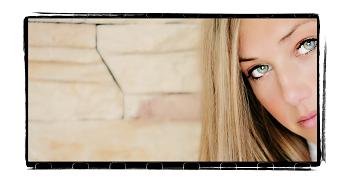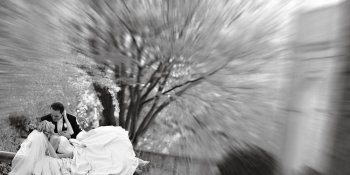articles/Weddings/flowposing-page1
Flow Posing - Doug Gordon - part 1 of 1
Published 01/11/2006

By Douglas Gordon
I am frequently asked what is the most important part of my job. My answer is always the same: consistency. I am paid to get it right the first time - there are no second chances in a wedding photographer's life. I am a firm believer in delivering what my clients see in my samples, that is the main reason I shoot in a system and, more importantly, why I created flow posing. I strive to make my images look candid - natural and unposed. My clients believe I am a photojournalist and I like that. However, the truth is I am the furthest thing from a PJ artist. Why did I choose to pose and how did I do it? My answers are simple. A true PJ artist is only as good as the couple and the wedding they are photographing. I don't feel secure in that scenario, as I never know how a wedding will play out. What do I do when they come back after the wedding to pick up the photos and they say, 'These look nothing like your samples.'? 'I am sorry, your wedding sucked.'? Somehow I do not think this will be too well received or, more importantly, be accepted by the client.
As photographers, we are pretty much always at the mercy of our clients: the way they act, their personalities, their guests and the uniqueness of their events. In my mind, if I am booked based on what I have done in the past, I had better do at least that and more. That is where systems come in. As we all know, we never have enough time for photos. We are always battling some type of obstacle whether it be the priest, the limo driver, the maitre d' or the crazy mother of the bride. Shooting within a system means I have a plan and an end goal. This is crucial. The most important thing I learned as a photographer came from my dad very early in my training and it is simple - never stop talking. You must always be heard and in control. The second you lose control, it's over. There is no time to think about what you need to do next. I never give my clients a chance to say no to me. I keep moving along at a very fast pace; so that they don't know what I am doing. I believe in the absence of real leadership - most people will listen to whoever is talking, so I will always be the one talking. I have watched the best PJ shooters in the world, seen their once-in-a-lifetime moments and worked hard to find a way to pose it.
This way every bride has it. Throughout the day I constantly take what I call 'filler shots' of hands, details and closed eyes (you can see an example of filler shots in this article). The best compliment I can get after the wedding is, 'I didn't remember this even happening'. The reason they don't remember it is because it probably never happened. People remember their wedding through my eyes, my feelings, my emotions and everything I am as a person. The other reason I pose them is, as a portrait guy, I learned how crucial it is to analyse the face to find the best angles. I believe in focusing on one side, not multiple angles as I feel this will only confuse the subject when the time comes for them to choose their photos. Now, the clincher - the lighting. I hate, hate, hate using on-camera strobe. I believe it is my mortal enemy.
If I choose to do these photos as they happen during the ceremony and reception, I am forced to use camera flash because of the dark lighting situations. Flash just wants to make me close down, pick up too much detail and cause harsh shadows. I shoot almost all my formal photos in available light whether I am indoors or outdoors. I love shooting wide-open; more than 90 per cent of my portraits are shot at f2.8 to f4. I use the wide-open aperture as a built-in softener because of the shallow depth of field. In other words, very little skin touch-ups in PS. As I do these filler shots throughout my formal session, I later plug them into the key moments of the wedding, such as walking down the aisle, first dance and many others. During these times I don't stress or, more importantly, become like paparazzi to my clients. I never want to interrupt the moment by having flash go off or being in the way. I tell my clients I want to be like an ancient Ninja: I am nowhere, but I am everywhere. Now during times when I would be chasing these shots, I am usually editing my images on my laptop somewhere so I don't have to do it when I get home . . . another story though. Like I said, everything is about systems. I have found that the faster I work, the more co-operation and respect I get from my subjects.

What is flow posing? The best way I define flow posing is the art of making the bodies flow systematically and uniformed. As we all know, men's and women's bodies are different. They are different in shape, size and proportion. The way they are created makes it very easy for them to be placed together in poses. In proper posing there must always be one subject more dominant. I begin my flow posing from the traditional pose of the bride and groom together with the dress out. We all have to do this whether we are a PJ artist or portrait photographer. I start with both bodies at a 45 degree angle to the camera, weight on the back hip and front toe forward. All of my poses for couples have three basic principles to them:
#1 tuck the back shoulder of the bride under the groom's armpit;
#2 roll out the front shoulder of both subjects away from the camera; and
#3 most importantly, lean both subjects forward at the waist.
These three rules are designed to decrease the size of the subject. The biggest thing we hear from our clients is that they want to look thinner and, as we all know, America is the biggest country in the world literally. This is another reason for me to pose. If I shoot these photos candidly, I do not have the same chance to decrease the subject's size. Now my goal on this set of flow posing is to do 35 poses of the bride and groom in under 5 minutes. That's right, you heard it, 35 poses in 5 minutes. It may seem impossible; it is anything but though. It all happens based on a few things. I always shoot on a tripod which allows my camera to stay in position at all times with minimal adjustment. Do the poses in the exact order I do them. As you can imagine I have done every combination you can think of and my poses work fastest with the exact order I have them in now. The most important in my opinion for every pose I do whether it is flow or not is that I must touch my subjects - I place them in every pose. It is quicker, easier and, more importantly, more time-efficient. Clock management on a wedding is crucial, I do not have time to say, turn your head this way or that way, put your chin down, lean forward, hold her hand higher. As Nike says, 'Just Do It'! By the time I say all these things I can be three poses ahead! I have designed this flow posing system so that each pose leads to another. I have them grouped in sets of between three and six so that it is easier for me to teach photographers. They all come from the original base pose of two people just standing there. You will see some of them on the following pages. The best way to learn is repetition. My photographers are constantly watching the videos and always have the posing guide with them. The order of the poses is essential.
Knowing the rules of posing is also a key component to breaking them. I learned the rules from the master, Monte Zucker and adjusted them to fit today's more sophisticated and open-minded clientele. The one thing I pride myself on is being flexible and open to change. The 35 poses are only a fraction of what I do with the bride and groom. On each wedding I take roughly 80-100 different poses of the bride and groom. There are no doubles. This whole process usually takes under 15 minutes and this only occurs because I have a plan. I have learned to adjust 'on the fly' accordingto subjects, locations and lighting conditions. The client doesn't care if this was wrong or they were too heavy or whiny to do this pose. They saw it, they want it and, therefore, it had better be there. No exceptions. I have so much more to say and show; unfortunately I am out of space. Remember you can make a system for every step of the wedding. I have, and after 3,000 weddings in 16 years I still love it. My systems change and evolve with each wedding. In order to learn more about Doug or his educational material, you can go to his studio website at www.patkenphotographer.com or his educational
site at www.douggordonworkshops.com.
You are currently on page 1
1st Published 01/11/2006
last update 09/12/2022 14:54:19
More Weddings Articles
There are 0 days to get ready for The Society of Photographers Convention and Trade Show at The Novotel London West, Hammersmith ...
which starts on Wednesday 15th January 2025





